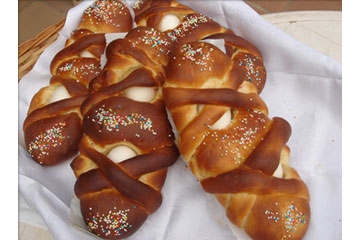The whole of the celebrations of Easter is adjusted to the national liturgical calendar. The festivities begin on Palm Sunday with the procession and blessing of bouquets and the High Mass.
On Wednesday the ‘Salpassa’ is celebrated, possibly the only municipality in the archdiocese of Valencia that preserves this ancient liturgical ritual in which the parish priest visited all the homes of the town to bless the water and salt. The priest kissed the Lignum Crucis (sacred relic of the True Cross, a beautiful piece of late Gothic goldwork that was present at the great Luis Vives Centennial Exhibition, held in the Lonja de Valencia in the fall of 1993) and collected the eggs with which each home gave the parish priest. The chiquillería accompanied the procession banging on sidewalks and doors to the rhythm of “Ous a la pallissa, ous al ponedor …”
The Mass of Holy Thursday, the feast of the institution of the Eucharist, has a special character and ends with the transfer of the Blessed Sacrament under a canopy to the Monument installed on the altar of the Immaculate Conception.
The recitation of the Via Crucis at the dawn of Good Friday on Calvary at the foot of the Green Horse takes on great solemnity in its simplicity. The popular melodies of the March and each of the stations constitute a beautiful sample of popular religious folklore, as well as the song of the ‘Miserere’ on the solemnity of the Holy Burial, celebrated on Friday night.
In another time, the Saturday of Glory covered a whole ritual of songs, purification of the waters, celebration of the Resurrection … practices that have now disappeared, which were mixed with the perfumes of ‘monas’ and ‘coques boves’ (pancakes) that came out from the ovens of Tonico and Pepe ‘el Forn’ (incomparable gastronomic tradition that today conserves the ‘Forn de Jan y Pepa’).
The three days of Easter celebration, with the children’s games and dances that are compiled in the publication Cançons del meu poble, by Daniel Sala, and in number XIII of the Coses del meu poble cassette, consisted of the traditional snacks of Easter: the first day, cute; the second, ‘cassoleta’; the third, ‘guisadet’; either in the Port of ‘Tía Quica’, in the era of Uncle Eduardo, or in the Font de Vernissa with the residents of Benichembla.


